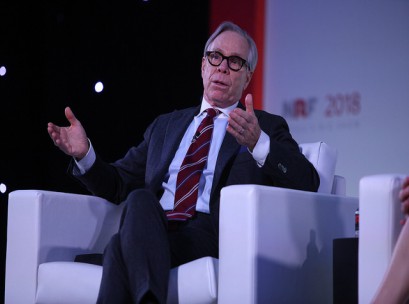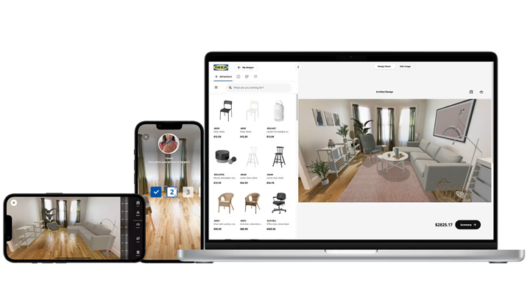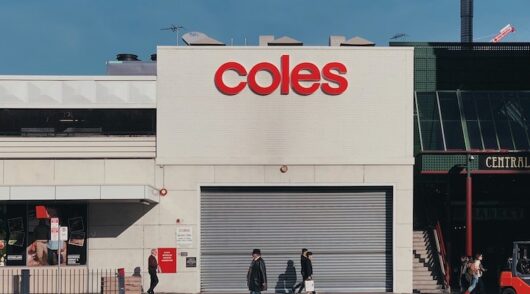
Here are the highlights from the third and final day of the NRF Big Show.
Take a look at insights from Day 1 and Day 2, plus keep an eye out for more coverage of the annual event in our weekly and quarterly magazines.
Consumer insights
Director of retail and consumer insights at NRF, Katherine Cullen, led a panel discussion on consumer behaviour with vice president of research at NRF, Mark Mathews, executive vice president for Prosper Insights & Analytics, Phil Rist and global managing director for consumer industries at IBM, Laurence Haziot.
According to the latest research from the NRF, consumer confidence in the US is at a record high this month, at 59 per cent. This is good news for retailers, but they still need to recognise the way customers want to shop is changing.
As Mathews noted, 73 per cent of bricks-and-mortar shoppers go into stores to buy specific products, while only 54 per cent of online shoppers go online with a specific product in mind. Consumers increasingly are browsing and searching for products online and buying them in store. Knowing this, he said, retailers should prioritise services like click-and-collect over new technology like augmented reality.
“Consumers are not looking for bells and whistles. They’re looking to buy online and pick-up in store and make digital payments online…Right now, the consumer is very focused on quick, easy, seamless, painless retail experiences,” he said.
Inside the Innovation Lab
More than 50 companies provided a glimpse of what retail could look like in the years ahead, from artificial-intelligence-powered digital screens personalising the in-store shopping experience to 3D printing providing the perfect fit for shoes. Here are a few of the companies we talked to:
– Entrupy offers smartphone-compatible hardware that takes microscope-level photos to identify counterfeit goods in nearly any category, from Louis Vuitton to Rolex watches.
– Bond gives businesses the ability to sent handwritten notes to customers at scale. It can capture any handwriting style and uses actual ink to provide a realistic look and feel.
– Locus provides mobile robots to make warehouse operations more efficient.
– Optoro helps retailers decide what do with items that are returned – whether selling them through the secondary market, or putting them back on the shelf – by considering the condition of each individual item.
Next-generation retailers: Brandless, Capsule, Zola
A trio of retail disruptors, including Tina Sharkey, founder of much-raved-about online grocery store, Brandless, Eric Kinariwala, founder of pharmacy app, Capsule, and Shan-Lyn Ma, founder of wedding registry site, Zola, spoke about the factors behind their recent success.
“The best brands and companies are internally and externally aligned. The way your team treats each other emanates out to the customer,” Kinariwala said.
Sharkey agreed that retailers should consider themselves warned. The growing number of direct-to-consumer brands indicates that the customer relationship is changing, especially among millennials.
“The number one factor for consumers is price and value. They want something built for them. The youth in this country want socially responsible and transparent brands,” she said.
Tommy Hilfiger disrupts with technology
Continuing with the trend that, far from dying, retail is flourishing, albeit changing, the final keynote at the NRF Big Show featured iconic fashion designer Tommy Hilfiger speaking with IBM’s Michelle Peluso about technology and transformation at the iconic fashion label.
Tommy Hilfiger was an early adopter of the see now, buy now trend in fashion and the first retailer to partner with Facebook Messenger on chatbots. The brand has embraced mobile shopping, such as ‘snap to shop’, and influencer marketing, striking advantageous partnerships with the likes of Gigi Hadid.
“Many years back, when we decided we should be technically advanced, it was a great decision because we were right on the cusp of change in retail. We were the reverse of that trend [of decline]… It all had to do with the fact that we embraced new technology and were not afraid to take risks,” Hilfiger said.
And while he noted that – to some extent – embracing the latest technology was part and parcel of being a “young” brand, the decision also had to do with the increasingly competitive retail landscape.
“If you fall behind…catching up is maybe not an option,” he said.
Indeed, Peluso is of the opinion that many established retailers – with their wealth of data – are better placed than some might think to thrive in this new retail era.
“Now is the time for the rise of the incumbent,” she said.





